Polar reversal is an enigma. Human history and the great ancient writers testify that the poles have reversed position on at least two occasions. There is historical evidence suggesting that on two additional occasions, significant polar displacement of a magnitude of 30° latitude occurred. Modern science does not have an ability to explain these events, nor recognize any evidence to substantiate their occurrence, so contemporary geologists will only suggest that the poles have reversed themselves at best, a few hundred million years ago. On the other hand, there is recognition that elsewhere in the universe, planets do indeed ‘roll over.’[1] This article contends that while there is a certain amount of fiction embedded in mythology and oral tradition, polar reversal events were not imagined. There is viable explanation for polar reversal, and it may be fair to assume there is no singular explanation. Several hypotheses are presented. (This article is not found in the book Enoch and the Watchers: Chronology of the Primeval Gods and the Western Sunrise. It is meant as further clarification of the theory presented in the book.)
Earth’s Polar Structure
To a very large degree, the understanding of polar reversals depends on understanding the earth’s polar structure, its reliance on the movement of the earth’s core, and the impact of electromagnetic and gravitational forces on the center mass (gravitational center) of earth located in the core.
The gravitational center (center mass) is not to be confused with the geomagnetic center, magnetic center, and geometric center, which are four separate and distinct, quantifiable phenomena. [2]
- The geometric center is the point equidistant from the circumference of the sphere. When the geometric center is not equal to the gravitational center (center of mass), the rotation is out of balance, creating a wobble effect.
- The gravitational center – “A body’s center of gravity is the point around which the resultant torque due to gravity forces vanishes. Where a gravity field can be considered to be uniform, the mass-center and the center-of-gravity will be the same.” This center aligns with the celestial pole, the gravitational axis
- The magnetic center – center point between the magnetic poles, the point defined by a line through the center of a magnet such that the torque exerted on the magnet by a magnetic field in the direction of this line equals The magnetic poles are the points at which magnetic needles indicate a the magnetic field lines penetrate the earth vertically (90°).
- The geomagnetic center is the point between the intersections of the Earth’s surface and the axis of a bar magnet hypothetically placed at the center the Earth. This center aligns with the geomagnetic poles.
These ‘geo centers’ help define three axes, or sets of poles, seen in Figures 1-3. These three sets of poles behave very differently, moving at different rates and directions. While there is an intrinsically compelling urge to believe magnetic and geo-magnetic poles should behave in a correlated matter, the data available suggests that is not the case. Pole location migration data, for both magnetic and geomagnetic poles, indicates asymmetric behavior for the poles of both models and that there is no significant correlation between the movement of the two magnetic axes of the two magnetic polar systems. [3]
- When measured from space (magnetosphere), the magnetic pole and geomagnetic pole appear to coincide, whereas from near space (less than 400 km altitude) the poles appear quite separately, as in Figure 1.[4]
- Magnetic dip poles move around, sometimes with daily frequency. The North magnetic pole has moved steadily northward at an average rate between 10 to 14 kilometers per year since it was first located in 1831, with more recent years seeing a rate of movement of 60 km/year.[5] On any given day, the magnetic pole may be as much as 80 kilometers away from its average position.
- The geomagnetic dipoles move at a slower rate. With an average of 8 km/year;
- For some periods but not all, the magnetic and geomagnetic poles move at simultaneous rates;
- The location of the North geographic pole wanders in a small erratic circle-like path, called the “Chandler wobble.” This motion is less than 6 meters per year on the surface;
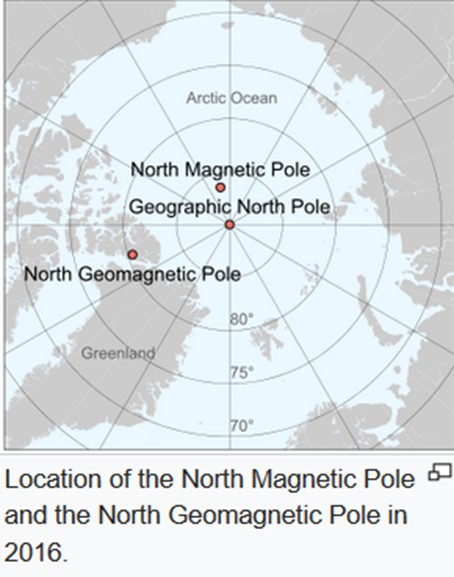 Figure 1: Pole Location
Figure 1: Pole Location
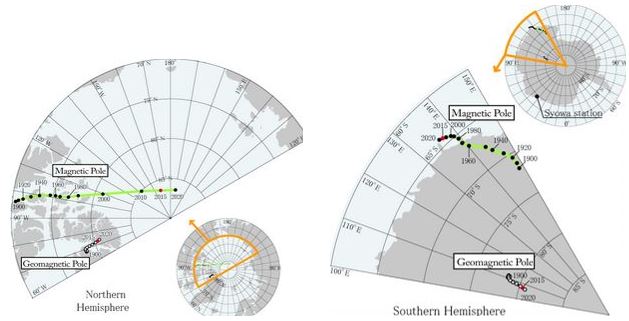
Figure 2: Pole Migration
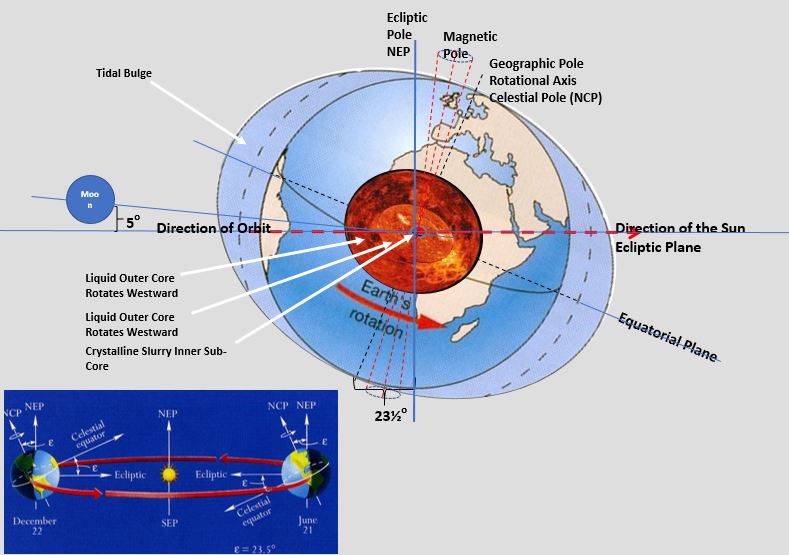
Figure 3: Polar Structure
The key observation taken from the above references is that each of these three center points can be demonstrated to be under the influence of a number of variables that affect speed, direction, and location of the earth’s center. The distance of the center migration is extremely limited, certainly less than a few kilometers. As the centers migrate within the core, so do their respective axes. The movement of the center mass produces the Chandler Wobble. The convection and spin in the outer core moves the geomagnetic center, and the movements of the inner core – both within the currents of the outer core, and the shifting center mass within the sub core will result in magnetic pole movement. The motion within the core is evident from the movement of the poles as well as various types of seismographic analyses which provide additional detail to that motion. Important to this understanding is a recognition that like the earth, the core layers are not perfect spheres, but rather oblate ellipsoids. There is some speculation that the inner core is somewhat pear-shaped The motion of these ellipsoids is predominantly horizontal and aligned with the earth’s rotation, but the migratory nature of the centers contributes to a wobble in the larger core.[6] To a very large degree these wobbles are self-correcting but occasionally, perturbations in the universe affect this dynamic balance. For anyone familiar with the physics of a toy tippe-top, and the physics of dynamic balance most commonly understood in association with tire balancing, the consequences of disrupting the dynamic balance can be catastrophic.
Like a tippe-top, when for any reason the earth’s center mass drops below the earth’s equatorial plane, the earth rolls over, and the north and south poles exchange places, until the center mass can be returned to its rightful position above or at the equatorial plane as a result of the torque force of the earth’s rotation. This should occur within a period of less than fifty years. In this respect, the earth behaves just as the toy tippe-top. When the earth rolls over like this, the magnetic and geo-magnetic poles will also roll with it, just as the rotation of a magnet does not change its polarity when it is rotated. No geomagnetic markers are left behind on the earth’s crust. This is an important observation. The geomagnetic poles can reverse without reversing the geographic poles because they operate under different forces and centers. Their migrations and reversals leave a record on the surface of the earth. The migratory nature of the geo-magnetic poles is an indication of turbulence in the inner and outer core. This turbulence in the core will affect the location of the center mass. The turbulence of the inner core can be viewed as a necessary but insufficient condition for a reversal of the geographic poles. However, a reversal of the geographic poles will drag the geo-magnetic field with it. The two axes will be aligned just as they were before the reversal, but there will be no demonstrable record magnetic record of the change on the earth’s surface.
Core Dynamics and Structure
The dynamics of the earth’s inner core are not fully understood by those who study it, but there is general alignment on some key dynamics.
- The earth’s core consists of an outer molten core, an almost solid inner core of super-heated metals, and an inner-inner core of crystalline structure.
- The outer core rotates westward and slower than the inner core, with at least two known rates, also described as large scale and small scale convection motion.
- Less fluid inner core rotates eastward, with variable speeds, with fastest direction being about 45 degrees from the polar axis, (providing the stabilizing torque that resets the reversal). The inner core is thought to ‘lap’ the outer core every 100-400 years.
- The crystalline inner-sub core experiences a drifting composition where the crystalline mass moves both up and down, both towards and away from the center, all while rotating with the inner core.
- All three centers (geo-center, magnetic center, gravitational center of mass) are considered to be in very close proximity to each other, but not in the exact same location. This displacement is the cause for the earth’s precession, the ‘Chandler wobble,’ and the migratory nature of the poles.
- The strength of the earth’s geo-magnetic field – generated at the core – is thought to be influenced by cosmic rays which pass through the earth. Observation indicates that the volume of cosmic rays entering the earth exceeds the volume departing, which in turn suggests that cosmic rays do indeed impact the earth’s core, in a manner not understood.[7]
The convection dynamics of the inner and sub core demand that the both the center mass and geo-magnetic center are always in motion relative to the axes and equatorial plane, explaining the drift of the geo-magnetic center, and the subsequent drift in the geo-magnetic poles. However, the gravitational center mass is defined by physics exterior to the core, including variables such as the tides and depth of the ocean, the moon, the sun, and the entire solar system. The inner core represents only 1.86% of the earth’s total mass, but as demonstrated in the comparison to tire balancing, less than a third of a percent of the mass acting as a counter-balance in the center can be the difference between stability and disaster.
While the polar reversals of 10,700 and 9,650 BCE may possibly be explained by a shift in center mass due to melting of the North American ice cap, the flip -or significant tilt -of the third millennium BC had no such corresponding event on the earth’s surface.[8] On the other hand, all three polar events seem to be associated with extreme solar flaring, which myth and history record. If one pursues the assumption that extreme solar flaring is related to the cause of the polar flip, one must accept that its explanation is in the realm of theoretical astrophysics, and virtually any theory presented without the corresponding math will be critically dismissed by academic experts[9]. Nevertheless, there is a layman’s logic to suggest that extreme solar flares can be at the root cause of polar reversal. The sequence of events flows as follows
- Prior to a solar flare, (33 to 40 hours prior) the sun starts to emit neutrinos. Solar neutrinos come in different categories, and can be emitted in different intensities based on 1) distance between the earth and sun, 2) the side of the sun which emits the neutrinos, and 3) the magnitude of the flare. Magnitude is a critical variable, and the assumption needs to be that the magnitude of the flare is several orders of magnitude greater than the Carrington Event of 1859. (This magnitude is clarified further into the article.)
- The neutrinos which precede the solar flare are considered responsible for reducing the rate of radioactive decay in various isotopes.[10] Reduced rates of decay associated with manganese-54, [11] chlorine-36 and carbon-14 have been attributed to solar flare neutrinos.[12] Reduced rates of decay translate to reduced radiation and reduced heat generation.
- Neutrinos are acknowledged to pass though the earth without difficulty, and it is assumed that neutrinos emitted by solar flares would pass through the earth (mantle, outer core and the earth’s inner core.)[13] The primary reason why neutrinos were suspected was because the reduced rate of decay continued during the night, and neutrinos were known to pass through the earth, unlike other solar emissions.
- Less neutrinos are measured coming out of the earth than the amount entering, which means the neutrinos are contributing to some transformative process.
- The earth’s inner core is heated by radioactive decay (much like fuel rods at a nuclear plant) and heat from the outer core. There are recent hypotheses that the inner core has a sub core which also produces radioactive decay and heat. The inner is primarily iron, with up to 5% weight Nickel, lighter alloying elements such as Sulfur, Oxygen, Silicon, Hydrogen, Carbon, Mg (Manganese) and K (Potassium). These lighter elements make up to 5-10% of the outer core, and 2-3% of the inner core.[14] Iron has 24 radioactive isotopes, suggesting both the inner and outer core are subject to reduced rates of radioactive decay due to neutrino bombardment. One would expect that the iron in the cores -subject to extreme pressure and temperatures- would be converted to heavier isotopes subject to radioactive decay. Iron-55 or 55Fe is a radioactive isotope of iron with a nucleus containing 26 protons and 29 neutrons. It decays by electron capture to manganese-55 and this process has a half-life of 2.737 years. The core is thought to contain up to 5-10% atomic Mg.[15] This suggests an ongoing cycle of radioactive decay of 55Fe
- An influx of solar neutrinos has been observed to reduce radioactive decay, so the assumption is that solar neutrinos reaching the earth’s core reduce radioactive decay and thus reduces the heat generated.
- Solar flares reduce atmospheric pressure which should contribute to a reduced pressure on the inner core, thus providing an environmental change of reduced pressure simultaneous with reduced heat in the core.
- Heating in the earth’s inner core is both a stable and a variable process, in that while there are pockets of heat transfer and heat generation, there are also pockets of cooling, and while these pockets are distributed throughout the inner core, one side of the core is thought to be cooling while the other side is considered to be heating, with both sides maintaining a state of equilibrium.[16] Cooling contributes to a crystallization of elements, which in time, expands the diameter of the inner core in a lopsided manner. The side which is predominantly crystalized grows a few hundred meters, and the melting side expands a few kilometers.[17]
- A change in the dimensions of the inner core changes the location of the center of mass. Vertical and 45° convection currents in the inner core, along with crystallization patterns mean that shifts in the center can be up or down as well as parallel with the equatorial plane.
After six years of analysis, no one has provided an explanation for how the rate of decay is reduced by neutrinos,
“But there’s one rather large question left unanswered. No one knows how neutrinos could interact with radioactive materials to change their rate of decay.
“It doesn’t make sense according to conventional ideas,” Fischbach said. Jenkins whimsically added, “What we’re suggesting is that something that doesn’t really interact with anything is changing something that can’t be changed.”
“It’s an effect that no one yet understands,” agreed Sturrock. “Theorists are starting to say, ‘What’s going on?’ But that’s what the evidence points to. It’s a challenge for the physicists and a challenge for the solar people too.”
If the mystery particle is not a neutrino, “It would have to be something we don’t know about, an unknown particle that is also emitted by the sun and has this effect, and that would be even more remarkable,” Sturrock said.”[18]
The hypothesis is that the temporarily reduced speed reduces torque (angular momentum) in the inner core, the center mass drops due to gravity, the earth rolls over, and is restored to its rightful position once the rate of radioactive decay is returned to normal and torque lifts the center mass to its normal position of balance.
Evidence for Polar Reversal
Part of the problem in gaining acceptance for this explanation is due to the fact that there is no recent record of cosmic activity at the level required to affect the core. Scientists in the current era seem to have underestimated the theoretical maximum energy output of a catastrophic solar flare by a thousand-fold. The theoretical maximum output of energy by solar flares was estimated to be 1026 joules with an average duration measured in seconds, possibly minutes.[19] These estimates – implying dangerous but not catastrophic consequences – significantly underestimate recently demonstrated potential. Two ancient texts from opposite sides of the world describe the heat prior to the great deluge as causing water to boil, requiring solar energy in the range of 1029 joules.
The Hebrew Talmud relates that the flaring prior to the event of 9650 BCE caused the oceans to boil. Assuming 1.33×109 cubic kilometers of water on earth, the amount of energy required to boil that water is 3.6×1029J. By comparison:
5.5×1024 J Total energy from the Sun that strikes the face of the Earth each year
energy release of typically
1 × 1020 Joules of energy for a normal solar flare
6.0×1025 J Energy released by a major solar flare (equivalent of 1 billion megatons of TNT)
3.8×1026 J Total energy output of the Sun each second
1026 Theoretical maximum of a solar flare
3.3×1031 J Total energy output of the Sun each day
The Mayan Popul Vuh describes the great deluge ending the Third Age of Man with the following text:
The deluge is preceded by a series of tragedies fallen from the sky which are highly reminiscent of those listed in the Atra Ḫasīs.
There came a rain of resin from the sky.
Here came one named Gouger of Faces: he gouged out their eyeballs.
There came sudden Bloodletter: he snapped off their heads.
There came crunching Jaguar: he ate their flesh.
There came Tearing Jaguar: he tore them open.
They were pounded down to the bones and tendons, smashed and pulverized even to the bones. Their faces were smashed because they were incompetent before their mother and father, the Heart of Sky, named Hurricane. [20]
The Popul Vuh then goes on to describe exploding fire-place hearth rocks and utensils: “The stones, their hearthstones were shooting out, coming right out of the fire, going for their heads….”[21] What is being described is the vaporization of water in rock and clay, making them explode. When one asks, how did anyone live to tell that story as they should have been ‘exploded’ as well, one realizes the preceding text describes exactly that – a witness testifying to discovering the remains of people killed by thermal flash. The witnesses to this event would have had to had been underground to survive heat in excess of 100 °C (212 °F). Rest assured, people around the world survived underground. Yuri Berezkin has recorded legends from over 400 cultures around the world describing the origins of man as emerging from under the earth.
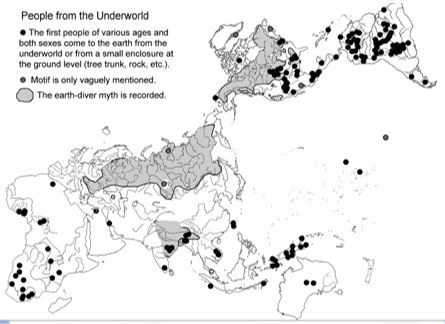
Figure 4: Tribal myths of the beginning of man‘emerging’ from under the earth.[22]
Whether these myths originate with the Great Deluge of 9650 BCE or the prior cataclysm of 10700 BCE may never be determined, but Hebrew legend clearly supports the solar flaring prior to the Great Deluge of Noah or Deucalion, but it also supports the notion that in 10700 BCE, the tribes of Adam and Eve went underground to survive.
Then Adam said to Eve, “When we were on the mountain we were comforted by the Word of God that conversed with us; and the light that came from the east, shone over us.
But now the Word of God is hidden from us; and the light that shone over us is so changed as to disappear, and let darkness and sorrow come upon us.
And we are forced to enter this cave which is like a prison.[23]
It may be appropriate to assume that the ‘flaming sword’ of Yahweh that drove early humankind from paradise into caves was the solar flaring preceding the end of the Second Age of Man, circa 11,100 BCE.
To appreciate the likelihood of a solar event of such a magnitude, one only needs to reflect on the record of satellite sensors of solar flares being ‘saturated’ on Nov. 4, 2013 for 11 minutes by a solar flare that exceeded that capacity of the sensor – designed to measure flares up to 1026 joules. The flare is officially recorded as an ‘X28+’ magnitude, suggesting the real magnitude was unknown. It was at the end of a series of major flares which began on October 28th with a solar flare recorded at a magnitude of X17 (and the fourth largest flare in recent history, 6.4×1025 joules) and included five major events over nine days until Nov. 5.[24] The second major eruption in the series was 5.7×1025. At these magnitudes, the radiation dose to a person on a highflying aircraft was equivalent to 1 chest x-ray. (The record left by the ancients suggest an impact thousand to ten thousand more severe.) Also noteworthy, while the typical transit time is for the solar flares’ impact to reach earth is two to three days, these more powerful storms took about 19 hours to reach earth. The largest flare, on November 4th occurred on the side of the sun facing away from earth, so the effects on earth were indirect and recorded as a minor storm. Had the eruption been earth facing, it probably would have reached earth faster than 19 hours. It was possibly 1000 times more powerful than the fourth most powerful solar flare on record.
Catalysts for Changes in Center Mass
The previous discussion on the structure and flow of the earth’s core was meant to demonstrate that the inner core, which represents 1.8% of the earth’s mass is in constant flux. A change in the location of the center mass due to convection currents in the core may alone be adequate to result in a serious wobble or polar reversal. This is important because of the known polar drift events, all were preceded by extreme solar flaring, but only the events prior to 9650 BCE were preceded by demonstrable alterations to the earth’s surface indirectly caused by the superwave of SgrA*. The large polar ‘tilt’ associated with what Velikovsky called the Age of Chaos (circa 2300 BCE) was not preceded by comparably large surface changes to the earth, but it does appear to have been preceded by solar flares and cosmic rays. There were maybe three changes to the earth’s gravitational definition of gravitational center mass: 1) re-distribution of the tidal bulge, 2) dispersion of magma through eruptions and wind, and 3) interstellar dust incursions that shifted gravitational forces.
A major shift in the earth’s center mass was caused by the glaciers melting, disbursing a large portion of the earth’s northern ice cap to the southern hemisphere. This value would approximate 4.719 kg, which is two-thirds of the weight of the North American ice melt, as two third of the ocean surface is in the southern hemisphere. This would tend to shift the center of mass towards the southern hemisphere.
Volcanoes may or may not shift the center mass (depending on magnitude), but a massive volcano, of a magnitude of 7-9 (or series of eruptions over time of a lesser magnitude) can move 1014 to 1016 kg of magma into the atmosphere and out of a specific earth location.[25] Two of the documented polar flips were preceded by massive flooding and volcanoes. In the instance of 10,700 BCE and 9,650 BCE, the flooding and volcanoes were near term. It is important to note that there is evidence to show that earthquakes in the magnitude of 7.5 or greater can amplify the wobble caused by precession.[26] In the case of the flip documented circa 1,500 BCE to 1,200BCE, there was a series of three major volcanic events within a space of ten years (circa 1,458 BCE) which together, had close to the same magnitude as the volcanic events of 10,700 BCE and 9,650 BCE, as measured by dust in the ice cores, but the lesser volume of magma moved took longer to generate a flip. It is important to remember that the number of rotations required to generate a significant wobble could be in the hundreds or thousands, meaning a time lag between the cause and effect could be substantial. The winds are going to keep this dust in the hemisphere of origin, and thus the center of mass may be affected, but probably not significantly.
The Kuiper Belt is the most logical source of an interstellar dust incursion, as it’s mass is missing 99% of its theoretical mass.[27] The Kuiper Belt is theorized to have had at one time a mass the size of 30 to 50 earth’s, but 99% of which is no longer there, and it is fair to assume it was blown away by the superwave of Sgr A*.[28] The displacement and movement of that mass would have had a significant impact of the location of the center mass in the direction of the force. It is known that dust clouds are affected by gravity, such that they are absorbed by the gravitational pull of a black hole. Hence, one may safely assume that the cloud exerts its own gravitational force regardless of how difficult it is to calculate distance. Related to this hypothesis, it is known that ices represent up to 1.4% of the belt’s mass and that interstellar sources could represent an incremental source of earth’s water, delivered by ice-rich meteorites and asteroids, called carbonaceous chondrites formed in asteroid belt that exists between the orbits of Mars and Jupiter.[29]
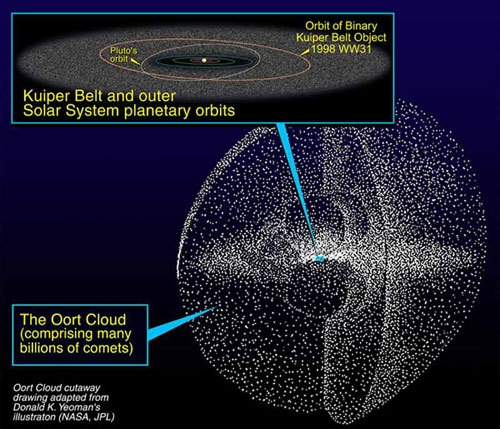
Figure 5: Kuiper belt[30]
Conclusion
Polar reversal is not only enigmatic. It is also taboo – a subject driven from discussion by ignorance and fear. Science denies it existence. History ignores its record. The phenomena that brought an end to the Second and Third Ages of Man and probably the First and Fourth Ages as well, is the most destructive force ever experienced by humankind. However, it is survivable. It is predictable. In the future, its occurrence will be better understood. Understood or not, it will happen. The path for humankind survival is best summed up as 1,2,3,4,5. 12 hours to shelter; 3 feet of dirt over-head; 4 weeks underground; 5 months of supplies. Go to high ground before going underground, as every large body of water will be transformed into a tidal wave. The tidal waves will not be immediate. At some time in the following 50 years, the process will reverse, foe which it can be assumed the solar flaring is not a component – just flooding.
Copyright by E. Peter Matrejek, March 2017
[1] Nola Taylor Redd, Alien Planet Is Rolling Over, Forcing 4 Others to Do Same, Space.com, November 30, 2011
[2] Anne Casselman on February 28, 2008The Earth Has More Than One North Pole, https://www.scientificamerican.com/article/the-earth-has-more-than-one-north-pole/
[3] M. Korte and M. Mandea, Magnetic Poles and Dipole Tilt Variation Over the Past Decades to Millennia, Earth Planets Space, Page 946-947.
[4] M. Korte and M. Mandea, Magnetic Poles and Dipole Tilt Variation Over the Past Decades to Millennia, Earth Planets Space, page 945.
[5] M. Korte and M. Mandea, Magnetic Poles and Dipole Tilt Variation Over the Past Decades to Millennia, Earth Planets Space, page 937.
[6] Earth’s equatorial diameter is 43 kilometers greater than the polar diameter.
[7] M. Korte and M. Mandea, Magnetic Poles and Dipole Tilt Variation Over the Past Decades to Millennia, Earth Planets Space, page 937.
[8] These polar events and evidence of their timeline is presented in detail in the author’s work Enoch and the Watchers: Chronology of the Primeval Gods and the Western Sunrise.
[9] Academic response to theories presented by researchers who are not vested in the specific discipline are not going to be welcomed, regardless of content. See Scientists Confront Velikovsky, edited by Donald Goldsmith, Cornell University Press, 1977. Nevertheless, there is a need to address this issue which no one in the ‘discipline’ has been willing to analyze, and to do so in language which is generally understood.
[10] “An Isotope is any of two or more forms of a chemical element, having the same number of protons in the nucleus, or the same atomic number, but having different numbers of neutrons in the nucleus, or different atomic weights. There are 275 isotopes of the 81 stable elements, in addition to over 800 radioactive isotopes, and every known element has isotopic forms.” From Dictionary.com
[11] Dan Stober, The strange case of solar flares and radioactive elements, Stanford Report, August 23, 2010
[12] There is a study which contends that solar neutrinos have no effect on the rate of decay. It is important to note that the study conclusions are constrained by the assumption of the “order of magnitude postulated.” Old textbook knowledge reconfirmed: Decay rates of radioactive substances are constant. October 10, 2014,
[13] “The fact that these neutrinos pass straight through the Earth with ease fit well with the fact that the decay rates were changing even at night, when the entire planet was between the radioactive isotopes and the Sun.” from Alasdair Wilkins, The Sun is changing the rate of radioactive decay, and breaking the rules of chemistry, 8/23/2010, MAD Science
[14] Lidunka Vočadlo, October 2006, paper on internet. See also Dan Stober, The strange case of solar flares and radioactive elements, Stanford Report, August 23, 2010
[15] Krisztina Kádas, Levente Vitos, Börje Johansson, and Rajeev Ahujaa, Stability of body-centered cubic iron–magnesium alloys in the Earth’s inner core
[16] Excess heat is extracted from and returned to the inner core by the mantle. David Gubbins, Binod Sreenivasan, Jon Mound & Sebastian Rost, Melting of the Earth’s inner core, Nature, Vol.473, May 2011.
[17] Marc Monnereau, Marie Calvet, Ludovic Margerin, Annie Souriau, Lopsided growth of Earth’s Inner Core, Science, Vol. 328, May 2010.
[18] Dan Stober, The strange case of solar flares and radioactive elements, Stanford Report, August 23, 2010
[19] Observatoire de Paris centre de recherche et enseignement en astronomie et astrophysique relevant du Ministère de l’Enseignement supérieur et de la Recherche. Solar flares energy : no apocalypse, December 20, 2012, https://www.obspm.fr/spip.php?page=imprimer&id_article=339&lang=fr
[20] Dennis Tedlock, Popol Vuh: The Definitive Edition of the Mayan Book of the Dawn of Life and the Glories of Gods and Kings, translated by Dennis Tedlock, Touchstone, Simon and Schuster, New York, 1986, page 84.
[21] Dennis Tedlock, Popol Vuh: The Definitive Edition of the Mayan Book of the Dawn of Life and the Glories of Gods and Kings, translated by Dennis Tedlock, Touchstone, Simon and Schuster, New York, 1986, page 86
[22] Map from Yuri Berezkin, The Emergence of the First People from the Underworld, Chapter 7 in New Perspectives on Myth, Museum of Anthropology & Ethnography (Kunstkamera), Russian Academy of Sciences, Saint-Petersburg, Russia.
[23] Second Book of Adam and Eve, in The Forgotten Books of Eden, by Rutherford H. Platt, Jr., 1926, page 19 at sacred-texts.com
[24] S.P. Plunkett, The Extreme Solar Storms of October to November 2003, 2005 NRI
[25] Haraldur Sigurdsson, Bruce Houghton, Steve McNutt, Hazel Rymer, John Stix, The Encyclopedia of Volcanoes, Elsevier, 2015, page 260.
[26] Kennett, J.P., and N.D. Watkins, “Geomagnetic Polarity Change, volcanic maxima and faunal extinction in the South Pacific”/ Nature, Volume 227, pages 930-934. Cited in Cataclysm, by Allen and Delair, page 183.
[27] Audrey Delsanti, David Jewitt, The Solar System Beyond The Planets. Institute for Astronomy, University of Hawaii. 2007.
[28] S. Alan Stern, Astronomy, April 2010: pages 30 to35.
[29] Andrew Fazekas, Mystery of Earth’s Water Origin Solved, National Geographic, October 30, 2014; Jesse Emspak, Where Did Earth’s Water Come From?, July 7, 2016, http://www.livescience.com/33391-where-did-water-come-from.html; Peter H. Gleick, Michael J. Cohen, The World’s Water 2008-2009: The Biennial Report on Freshwater Resources, Island Press, Mar 5, 2013, page 5.
[30] http://www.space.com/16144-kuiper-belt-objects.html, Donald Goldsmith, Mining The Asteroids: Who Decides?, http://www.rawscience.tv/mining-the-asteroids-who-decides/, March 2015; Enrico de Lazaro, Carbonaceous Chondrites as Source of Earth’s Water, July 16, 2012, http://www.sci-news.com/space/article00466.html
Copyright by E. Peter Matrejek
